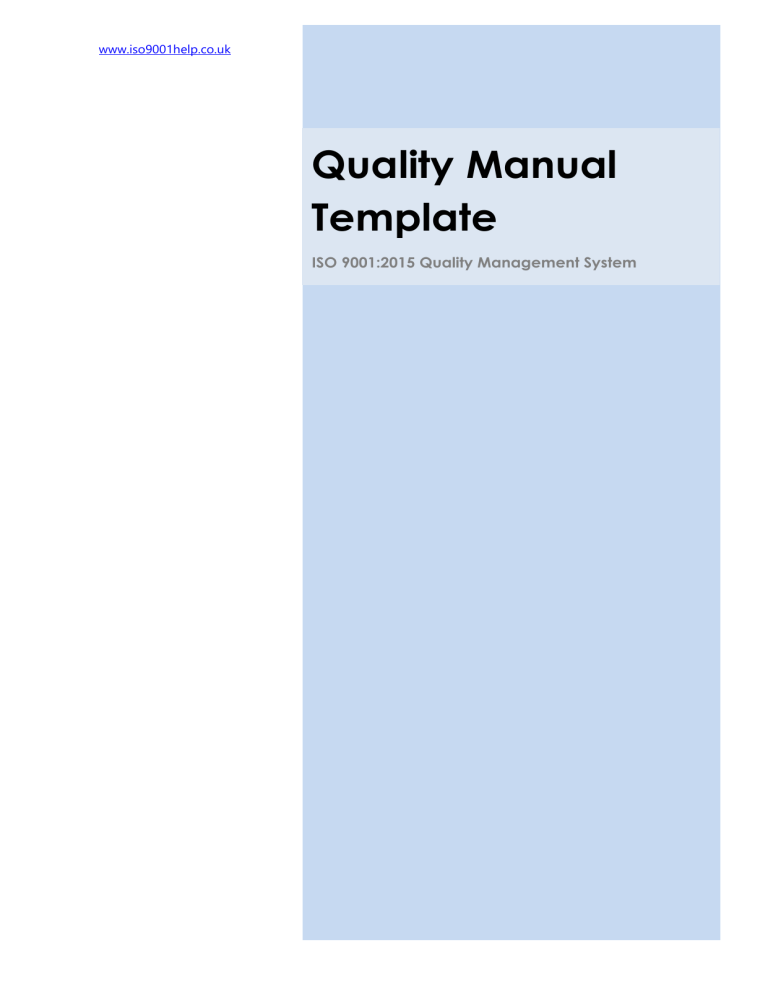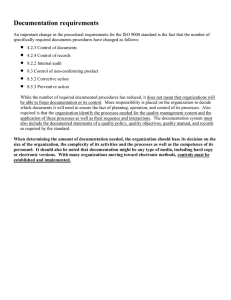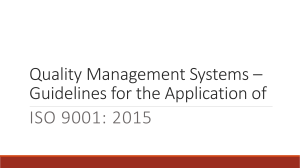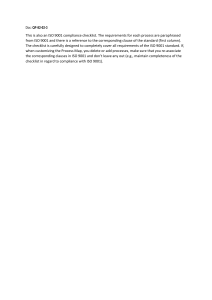
www.iso9001help.co.uk Quality Manual Template ISO 9001:2015 Quality Management System Quality Manual Template www.iso9001help.co.uk ISO 9001:2015 Quality Management System Table of Contents 1 INTRODUCTION ............................................................................................................................................... 5 2 QUALITY MANAGEMENT PRINCIPLES ......................................................................................................... 6 3 REFERENCES & DEFINITIONS......................................................................................................................... 6 4 CONTEXT OF THE ORGANIZATION .............................................................................................................. 8 5 4.1 ORGANIZATIONAL CONTEXT........................................................................................................................................................ 8 4.2 RELEVANT INTERESTED PARTIES................................................................................................................................................... 9 4.3 QUALITY MANAGEMENT SYSTEM SCOPE ................................................................................................................................... 9 4.4 QUALITY MANAGEMENT SYSTEM PROCESSES ......................................................................................................................... 10 LEADERSHIP ...................................................................................................................................................12 5.1 LEADERSHIP & COMMITMENT ................................................................................................................................................... 12 General.............................................................................................................................................................................. 12 Customer Focus ............................................................................................................................................................. 13 5.2 QUALITY POLICY .......................................................................................................................................................................... 13 Establishing the Quality Policy ................................................................................................................................ 13 Communicating the Quality Policy ........................................................................................................................ 14 Quality Policy Statement ........................................................................................................................................... 14 5.3 ROLE, RESPONSIBILITIES AND AUTHORITIES ............................................................................................................................. 15 Top Management ......................................................................................................................................................... 15 Quality Manager ........................................................................................................................................................... 15 Quality Coordinators ................................................................................................................................................... 16 Managers & Supervisors ........................................................................................................................................... 16 Employees & Contractors ......................................................................................................................................... 16 6 MANAGEMENT SYSTEM PLANNING ..........................................................................................................17 6.1 ADDRESSING RISKS & OPPORTUNITIES .................................................................................................................................... 17 6.2 QUALITY OBJECTIVES & PLANNING TO ACHIEVE THEM ......................................................................................................... 18 Establishing Quality Objectives ............................................................................................................................... 18 Plans to Achieve Quality Objectives ...................................................................................................................... 19 6.3 7 PLANNING FOR CHANGE ............................................................................................................................................................ 19 SUPPORT .........................................................................................................................................................21 7.1 RESOURCES .................................................................................................................................................................................. 21 General.............................................................................................................................................................................. 21 People ............................................................................................................................................................................... 21 Infrastructure .................................................................................................................................................................. 21 Operational Environment .......................................................................................................................................... 22 Monitoring & Measurement Tools ........................................................................................................................ 22 Organizational Knowledge ....................................................................................................................................... 23 7.2 COMPETENCE ............................................................................................................................................................................... 24 Document Ref. Page 2 of 51 Quality Manual Template www.iso9001help.co.uk ISO 9001:2015 Quality Management System 7.3 AWARENESS ................................................................................................................................................................................. 24 7.4 COMMUNICATION ....................................................................................................................................................................... 25 7.5 DOCUMENTED INFORMATION ................................................................................................................................................... 26 Management System Documents .......................................................................................................................... 26 Creating & Updating ................................................................................................................................................... 27 Controlling Documented Information.................................................................................................................. 27 8 OPERATION ....................................................................................................................................................28 8.1 OPERATIONAL PLANNING & CONTROL.................................................................................................................................... 28 8.2 CUSTOMER REQUIREMENTS ....................................................................................................................................................... 28 Customer Communication ........................................................................................................................................ 28 Determining Requirements ...................................................................................................................................... 29 Review of Requirements ............................................................................................................................................ 29 Changes in Requirements ......................................................................................................................................... 29 8.3 DESIGN & DEVELOPMENT.......................................................................................................................................................... 30 General.............................................................................................................................................................................. 30 Planning............................................................................................................................................................................ 30 Inputs................................................................................................................................................................................. 31 Controls ............................................................................................................................................................................ 31 Outputs ............................................................................................................................................................................. 32 Changes ............................................................................................................................................................................ 32 8.4 CONTROL OF SUPPLIERS & EXTERNAL PROCESSES ................................................................................................................. 32 General.............................................................................................................................................................................. 32 Purchasing Controls .................................................................................................................................................... 33 Purchasing Information .............................................................................................................................................. 34 8.5 PRODUCTION & SERVICE PROVISION ....................................................................................................................................... 34 Control of Production & Service Provision ........................................................................................................ 34 Identification & Traceability ..................................................................................................................................... 35 3rd Party Property.......................................................................................................................................................... 35 Preservation .................................................................................................................................................................... 36 Post-delivery Activities ............................................................................................................................................... 36 Control of Changes ...................................................................................................................................................... 37 9 8.6 RELEASE OF PRODUCTS & SERVICES ......................................................................................................................................... 37 8.7 CONTROL OF NON-CONFORMING OUTPUTS .......................................................................................................................... 38 PERFORMANCE EVALUATION .....................................................................................................................39 9.1 MONITORING, MEASUREMENT, ANALYSIS & EVALUATION ................................................................................................... 39 General.............................................................................................................................................................................. 39 Customer Satisfaction ................................................................................................................................................. 39 Analysis and Evaluation .............................................................................................................................................. 40 9.2 INTERNAL AUDIT.......................................................................................................................................................................... 41 General.............................................................................................................................................................................. 41 Internal Audit Programme ........................................................................................................................................ 41 Document Ref. Page 3 of 51 Quality Manual Template www.iso9001help.co.uk ISO 9001:2015 Quality Management System 9.3 MANAGEMENT REVIEW .............................................................................................................................................................. 42 General.............................................................................................................................................................................. 42 Inputs................................................................................................................................................................................. 42 Outputs ............................................................................................................................................................................. 42 10 IMPROVEMENT ..........................................................................................................................................43 10.1 GENERAL....................................................................................................................................................................................... 43 10.2 NON-CONFORMITY & CORRECTIVE ACTION ........................................................................................................................... 43 10.3 IMPROVEMENT ............................................................................................................................................................................. 44 APPENDICES ...........................................................................................................................................................45 A.1 CORRELATION MATRIX ............................................................................................................................................................... 45 A.2 QMS PROCESSES INTERACTION................................................................................................................................................ 48 A.3 ORGANIZATION CHART .............................................................................................................................................................. 49 A.4 QUALITY MANAGEMENT SYSTEM DOCUMENT INDEX ............................................................................................................ 50 A.4.1 Schedule of Procedures ............................................................................................................................................. 50 A.4.2 Schedule of Report & Forms.................................................................................................................................... 50 A.4.3 Schedule of Audit Documents ................................................................................................................................ 50 Document Ref. Page 4 of 51 Quality Manual Template www.iso9001help.co.uk ISO 9001:2015 Quality Management System 4 Context of the Organization 4.1 Organizational Context Your organization is committed to defining our position in the marketplace and understanding how relevant factors arising from legal, political, economic, social and technological issues influence our strategic direction and our organizational context. To ensure that our quality management system is aligned with our strategy, whilst taking account of relevant internal and external factors; we collate and analyze pertinent information in order to determine the potential impact on our context and subsequent business strategy. Figure 2: Examples of Internal & External Influences Your organization identifies, analyzes, monitors and reviews factors that may affect our ability to satisfy Types of external influence • Regulations • Competition • Innovation • Technology • Environment • Globalization our customers and stakeholders, as well as; factors that may adversely affect the stability of our processes and the integrity of the management system. Broadly, these issues are defined as: Internal issues are conditions related to our organizational Types of internal influence • Values • Strategy • Competence • Culture • Knowledge • Performance activities, products, services, strategic direction, culture, people, size, complexity, knowledge, performance, processes and systems. Using SWOT analysis provides our organization Organizational Context with framework for reviewing and evaluating our strategies, and the position and direction of our organization, business propositions and other ideas. External issues are factors that exist outside of our organization that are related to statutory and regulatory requirements, industry requirements and agreements, competition, globalization, innovations, technology and natural environment. Using PESTLE analysis provides our organization with framework for measuring our market and growth potential according to external political, economic, social, technological, legal and environmental factors. Your organization monitors and reviews this information to ensure that a continual understanding of each party’s requirements is derived and maintained. To facilitate the understanding of our context, we regularly consider issues that influence our context during management review meetings using the Context & Interested Party Analysis template. The results of which are conveyed via minutes and business planning documents. We maintain and retain; in addition to this document, the following documented information to describe our organizational context and decisions relating to it: 1. Analysis of business plans, strategies, and statutory and regulatory commitments; 2. Analysis of technology, competitors, economic reports from relevant business sectors or from technical experts and consultants; Document Ref. Page 8 of 51 Quality Manual Template www.iso9001help.co.uk ISO 9001:2015 Quality Management System 5 Leadership 5.1 Leadership & Commitment General Your organization’s leadership is responsible for implementing our QMS, including the development and deployment of our quality policies, subsequent objectives and targets, and product or project-specific plans which are customer focused. Top management provides accountability and governance to all activities related to the lifecycle processes including defining the strategic direction, responsibility, authority, and communication to assure the safe and effective performance. Top management ensures that all necessary Figure 4: Leadership PDCA Cycle resources, responsibilities and accountabilities are allocated for the continual improvement of the QMS. Refer to Appendix A.3 for a copy of our Organization Chart. Top management have appointed and delegated the responsibility and authority for managing our quality processes to the Quality Manager to ensure that the necessary financial, technological and organizational resources are available to implement, monitor and maintain the QMS as required. Your organization’s governance structure provides necessary support for creating and establishing processes that are important for achieving our quality Leadership objectives, targets and policies by using the PDCA approach. Governance activities include the systematic verification of QMS effectiveness by undertaking internal audits and analyzing performance data, reviewing trends and KPIs. Regular reviews and data reporting ensure that our QMS is effective and has the ability to react to emerging issues. Top management is committed to implementing and developing the QMS and this • Plan Establish your context and strategies. Determine regluatory and statutory commitments. • Do Develop policies and objectives. Provide resources, assign process owners. Focus on improvement. Address risks, opportunities and adverse impacts. • Check Review system and process performance data, ensure alignment is maintained between context and strategy. Review policy and objectives. • Act Agree changes and implement activties to improve the QMS and its processes. commitment is defined by our corporate policies and objectives. Evidence of Top management’s involvement and commitment may be found in: 1. Business strategy plans and meetings; 2. Policies, objective and goals; and their communication and incentivization; 3. Information provided on our website or social media channels; 4. Annual reports; 5. Management meeting minutes. Document Ref. Page 12 of 51 Quality Manual Template www.iso9001help.co.uk ISO 9001:2015 Quality Management System 6 Management System Planning 6.1 Addressing Risks & Opportunities In order for our organization to have a successful quality management system, we consider and manage the risks and opportunities relating to our stakeholders, and our external and internal context. This process uses the information collected during context and strategy evaluations (via SWOT & PESTLE analysis) and stakeholder and interested party analysis. Risk and opportunity management is undertaken as part of your organization’s day-to-day operations to capture and react to perceived risk and opportunity, ensuring each issue is managed at the most appropriate level within our organization. The aim of risk and opportunity management within Figure 5: Risk Evaluation as a 7-step Process your organization is to ensure that organizational Plan capabilities and resources are employed in an efficient Identify and effective manner to take advantage of opportunities and to mitigate risk to: 1. Strategic direction and business planning (4.1); 2. Interested parties (4.2) 3. Management system and processes (4.3); 4. Products (8.1); 5. Suppliers (8.4). Your organization considers and manages the risks and Monitor Assess Risk Evaluation Cycle Report Repsond opportunities relating to our stakeholders, our external and internal context, and ultimately the QEHS Review management system. This process uses the information collected during context and strategy evaluations (SWOT analysis and PESTLE analysis), context and interested party analysis, and from the evaluation of health and safety hazards and environmental aspects. Your organization considers the risks and opportunities and takes action to ensure that our QEHS management system meets its intended outcomes and achieves continual improvement. All risk and opportunity management activities and related decisions are recorded in the Risk & Opportunity Register as well as in Management Review Minutes. Top management are responsible for incorporating risk-based thinking in to our organization's culture. This includes the establishment of risk management procedures and processes to ensure the effective risk and opportunity management principles are undertaken throughout the lifecycle of our management system, products, services and activities by: 1. Providing sufficient resources to carry out risk and opportunity management activities; 2. Assigning responsibilities and authorities for risk and opportunity management activities; 3. Reviewing information and results from audits and risk and opportunity management activities. Document Ref. Page 17 of 51 Quality Manual Template www.iso9001help.co.uk ISO 9001:2015 Quality Management System 7 Support 7.1 Resources General Resources at your organization include human resources and specialized skills, infrastructure, technology, work environment and financial resources. The resource requirements for the implementation, management, control and continual improvement of the quality management system, and activities necessary to enhance customer satisfaction, are defined in our operational procedures, work instructions and the following sections of this quality manual: 1. Planning; Section 6.0 2. Management review; Section 9.3 3. Human resources; Section 7.1.2 4. Infrastructure; Section 7.1.3 5. Work environment; Section 7.1.4 6. Planning of product realization; Section 8.1 7. Determination of customer requirements; Section 8.2 People To ensure competence of our personnel, job descriptions have been prepared which identify the qualifications, experience and responsibilities that are required for each position that affects product and quality management system conformity. Qualifications include desired requirements for education, skills and experience. Appropriate qualifications, along with the provision of any required training, provide the competence required for each position. Qualifications are reviewed upon hire, when an employee changes positions or the requirements for a position change. The Human Resources Department maintains records of employee qualifications. If any differences between the employee’s qualifications and the requirements for the job are found, training or other action is taken to provide the employee with the necessary competence. The results of training are then evaluated to determine if it was effective. Staff training records are maintained to demonstrate competency and experience. The Human Resources Department maintains and reviews the training records to ensure completeness and to identify possible future training needs. Training records are maintained and include as a minimum; copies of certificates for any training undertaken to date, current job description and curriculum vitae. The requirements for training are communicated by the Competence & Awareness Procedure. Infrastructure Your organization is responsible for planning, providing and maintaining the resources needed to achieve product and process conformance, including buildings, workspace and associated utilities; process equipment (hardware and software); and supporting services (such as internal transportation and material handling systems and communications systems). The Facilities Manager in conjunction with the Quality Manager has overall responsibility for managing our facilities and equipment maintenance programmes which include: Document Ref. Page 21 of 51 Quality Manual Template www.iso9001help.co.uk ISO 9001:2015 Quality Management System 8 Operation 8.1 Operational Planning & Control Your organization establishes and implements documented plans and procedures that describe the processes identified in Section 4.3.2 and the controls required for the provision of products and services in cognizance to our objectives, the potential for planned or unintended change, and the risks and opportunities identified in Section 6.1. During the planning phase, Top management, the Quality Manager and other responsible personnel identify the following parameters: 1. Objectives and requirements for the product or service; 2. Verification, validation, monitoring, inspection and test requirements; 3. Documented information to demonstrate conformity; 4. Related life risks and opportunities; 5. Documented information to demonstrate conformity; 6. Necessary resources; or outsourced processes and their controls; 7. Criteria for process performance and product/service acceptance; 8. Potential consequences and mitigation to change affecting input requirements; 9. Resources necessary to support the ongoing operation and maintenance of the product. The output of this planning activity includes documented plans, resource schedules, processes, equipment requirements, procedures and design outputs. Design and development activities targeted at controlling risks are supported by documented information. This documentation relates the design activities to identified risks in a way that provides objective evidence that the nature and extent of the design control is reasonable and appropriate to the degree of risk. 8.2 Customer Requirements Customer Communication In accordance with our commitment to exceed our customer’s expectations, your organization highlights effective customer communication as an essential element of delivering customer satisfaction. Appropriate handling of customer communication helps to reduce customer dissatisfaction and, in many cases, turn a dissatisfying scenario into a satisfying experience. Customer communication occurs through the following formats, events and processes: 1. Brochures, specifications or technical data sheets relating to our products and services; 2. Enquiries, quotations and order forms, invoices and credit notes; 3. Confirmation of authorized orders and amended orders; 4. Delivery notes and certificates of conformity; 5. E-mails, letters and general correspondence; 6. When customer property is handled or controlled; 7. Customer feedback and complaints management process; The Customer Service Team and Sales & Marketing Department are responsible for establishing methods of communication with our customers to ensure enquiries, contracts or order handling; including amendments, customer feedback and complaints are handled expeditiously and professionally. Document Ref. Page 28 of 51 Quality Manual Template www.iso9001help.co.uk ISO 9001:2015 Quality Management System 9 Performance Evaluation 9.1 Monitoring, Measurement, Analysis & Evaluation General Your organization applies suitable methods for determining which aspects of the quality management system and its processes are to be monitored, measured and evaluated. The frequency and methods by which our processes are monitored, measured and evaluated is determined and informed by: 1. Statutory and regulatory requirements; 2. Customer feedback and specification requirements; 3. Process and QMS requirements; 4. Process performance and audit results; 5. Level of risk and types of control measure; 6. Trends in non-conformities or corrective actions; 7. Criticality for product conformity. All monitoring, measuring and evaluation outputs are documented and analyzed to determine process effectiveness and to ensure their effectiveness in achieving in-tolerance results, and to identify opportunities for improvement. 1. In-process checks relate to both quality control and productivity checks; 2. Provision is made for the identification and resolution of non-conformances; 3. The emphasis is to prevent any problems which might affect customer satisfaction; 4. In-process checks are performed and documented; 5. Where specific inspection points are required these are identified at the contract planning phase. Where applicable, test and inspection records are retained as documented information for a minimum of three years. This documented information includes derails of the final inspection authority to confirm that all critical parameters were in accordance with established requirements and specifications. Additionally, product samples are stored for a minimum of five years. Products are not normally released or delivered until all planned inspections and tests have been completed and that documented information exists to provide evidence of conformity with acceptance criteria and identifying the person(s) authorizing release. In rare cases (due to customer requirements and/or production emergencies) unverified product may be released or delivered under controlled conditions of positive recall, as documented and authorized by the Quality Manager and, where applicable, approved by the customer. Customer Satisfaction The success in meeting our customer’s requirements and in achieving a high level of customer satisfaction with your organization’s products and services is evaluated on a regular basis, at least monthly. This is done using, but is not limited to, on-time delivery performance, warranty analysis, in-service performance monitoring, customer complaint analysis, annual customer satisfaction surveys, and other appropriate means. The customer satisfaction results are summarized for discussion at management reviews. Your organization has developed and implemented plans for customer satisfaction improvement that address any deficiencies identified by these evaluations and to assess the effectiveness of the results. Your organization Document Ref. Page 39 of 51 Quality Manual Template www.iso9001help.co.uk ISO 9001:2015 Quality Management System 10 Improvement 10.1 General The Quality Manager uses a range of the performance evaluation tools highlighted in Section 9 to make recommendations for improvement and to achieve the intended outcomes of our quality management system. For example, recommendations may emerge from the review groups and from findings raised in internal audits. In order to determine and select opportunities for improvement or to implement any necessary actions to meet the requirements of customers and relevant interested parties, or to enhance customer satisfaction, your organization drives improvement via the analysis of relevant data. The data inputs for the improvement process include: 1. Risk and opportunity evaluations; 2. Assessment of the changing needs and expectations of interested parties; 3. The conformity of existing products and services; 4. The effectiveness of our quality management system; 5. Supplier performance; 6. Reducing unintended consequences; 7. Increasing beneficial impact and opportunities; 8. Levels of customer satisfaction, including complaints and feedback; 9. Internal and external audit results; 10. Corrective action and non-conformance rates; 11. Data from process and product characteristics and their trends. Your organization also ensures that opportunities for improvement from daily feedback on operational performance are evaluated by the Quality Manager as appropriate. Changes are typically implemented through the corrective action system. Opportunities for improvement from analysis of longer-term data and trends are evaluated and implemented through the management review process and are prioritized with respect to their relevance for achieving our quality objectives. The overall effectiveness of continual improvement program (including corrective actions taken as well as the overall progress towards achieving corporate level improvement objectives) is assessed through our management review process. 10.2 Non-conformity & Corrective Action Non-conformities with aspects of quality and the requirements of ISO 9001:2015 are reported to the Quality Manager in order that an investigation can be initiated, in which case, the Non-conformity & Corrective Action Procedure is referred to. The appropriate manager documents the non-conformity using the Non-conformance Report and considers the root-cause of the non-conformity. If necessary, other responsible parties will be consulted to identify the root cause and plan appropriate action. The Quality Manager records the report together with any agreed corrective action within the Corrective Action Log. The results of the corrective action are recorded within the Corrective Action Report. Document Ref. Page 43 of 51






